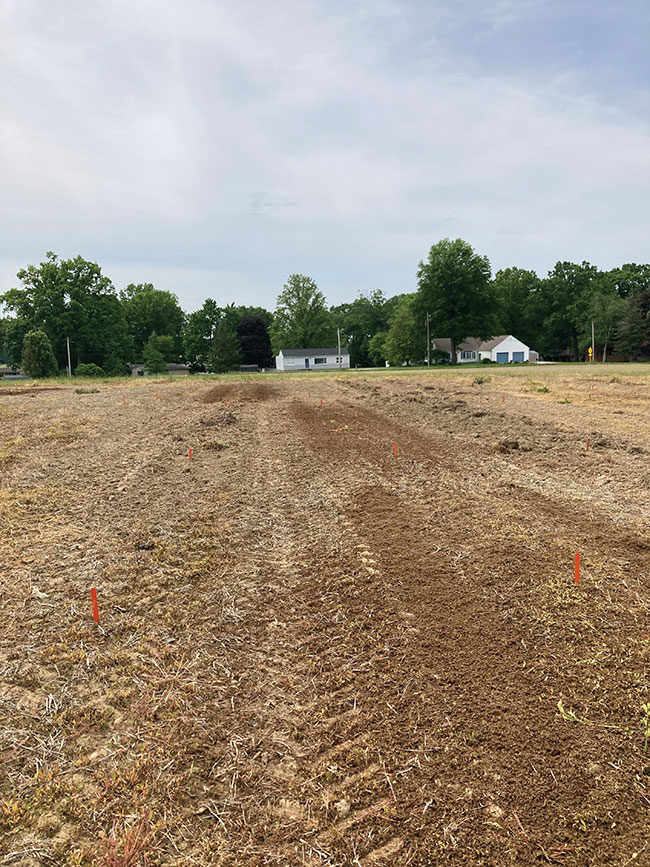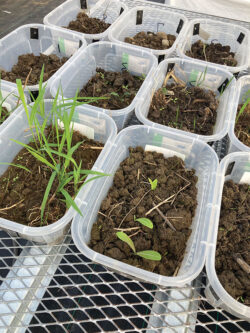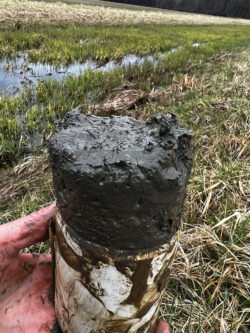
Features
Don’t ditch the topsoil!
Spreading soil dredged from ditches back onto farmland.
November 7, 2023 By Jack Kazmierski
 Replicated field experiment with control field conditions and various plots amended with ditch soil, dairy manure solids, or ditch subsoil. Half of the plots received chemical fertilizers at standard agronomic rates. Yield response was measured over a two-year corn-soybean rotation.
Image courtesy of Jonathan Witter
Replicated field experiment with control field conditions and various plots amended with ditch soil, dairy manure solids, or ditch subsoil. Half of the plots received chemical fertilizers at standard agronomic rates. Yield response was measured over a two-year corn-soybean rotation.
Image courtesy of Jonathan Witter Agricultural ditches go hand-in-hand with subsurface tile drains. You can’t have one without the other, which is why we see both throughout parts of the Midwestern United States where poorly drained soils are the norm.
Over time, however, these man-made ditches tend to fill up with sediment, and they need to be dredged as part of a regular ditch maintenance program. “Silt tends to build up, and it blocks the tile outlet,” explains Jonathan Witter, associate professor, agricultural and engineering technologies, Ohio State Agricultural Technical Institute Wooster.
In order to deal with the silt issue, the farmers themselves, or the drainage contractors they hire remove the silt, and pile it up on land nearby. How often a ditch needs to be dredged varies. “I’ve worked in places where they were dredging every one to two years,” says Witter. “Most of our drainage maintenance programs are between five and 10 years, but some ditches may not have been cleaned out for many decades. So it’s highly variable.”
Although piling the silt onto the field at the top of the ditch is the easiest and most economical solution, it comes with a price: Placing all that soil at the top of the ditch can impede surface drainage, which in turn can negatively impact crop growth. Over time, that pile of earth can simply fall back into the ditch, filling it up again.
Nutrient rich soil
That’s why Witter, along with a group of researchers, is looking into another solution to the dredging issue. Instead of putting the silt into a pile near the top of the ditch, he and his team wondered if there’s a better way to deal with the problem.

Greenhouse experiment to germinate the weed seed bank from dredged soil and sediments from nine ditches in Ohio.
Image courtesy of Dan Mecklenburg
“You have to keep in mind that this is nutrient-rich topsoil,” he explains. “So, what we’re looking at is whether we can use it as a soil amendment or as an alternative to fertilizer.”
Witter believes that the value of this dredged nutrient-rich soil can be leveraged in order to improve the overall quality of the soil within a given field. “If there are areas in a field that have been negatively impacted because of erosion, for example, can we improve those areas?” he asks. “We’ve done a lot of work to determine how valuable that dredged soil is, and discovered that it’s packed with a lot of nutrients.”
Economic sense
One of the other questions Witter and his team want to answer is whether this practice makes economic sense. “We’re looking at whether we can use drainage contractors, who are already doing ditch maintenance, to take that soil from the edge of the field and spread it out in a nearby field,” Witter explains. “We’re not asking them to transport dredged soil from far away. It’s just going from the edge of the field onto other parts of the field.”
The costs associated with spreading dredged soil onto a field could be offset, at least in part, by the value of that soil, Witter believes. “When fertilizer prices were fairly high, we found that every cubic yard of dredged soil had about $8 worth of nutrients in it. So that’s real value, and it’s a fertilizer alternative.”
Promising results
So far, the results from the research look promising, although Witter is quick to stress that these are just preliminary findings and that a lot more research still has to be completed.

Sediment extracted from a conservation ditch design constructed in northern Ohio is 2012.
“In the small plot of land where we did our research, we found that there was no significant difference between chemical fertilizers and simply applying the sediment to the field,” he says. “Actually, we found that the part of the field where we applied the sediment had a higher crop yield.”
The experiment was conducted in a field with corn/soybean rotations. “We found that the sediment-amended plots of land had a significantly higher soybean yield,” adds Witter, “to the tune of about eight bushels per acre, versus our control field, where we used chemical fertilizers.”
The question now is whether the added cost of spreading the dredged soil onto a field is worth it. “There is an additional cost to this… we’re now doing an economic analysis.”
So the now: which option makes more sense financially. On the one hand, there’s the cost of the fertilizer and applying it. On the other hand, dredged soil is free, and it results in a larger crop yield, but there’s a cost associated with spreading it, as well.
It’s too early to tell which option is best, warns Witter, simply because the research isn’t finished. “We’re going to collect this year’s harvest data to see if there was a yield benefit again. If there is, we’ll probably do it for another year to see the results.”
Witter has an open mind about the research and understands the need to study this question in other areas as well. “The benefits could be greater at another site, or they may be inconsequential at another site,” he explains. “That’s why we need to expand out and apply this to different places to see if we get the same results.”
Other benefits
Beyond costs and crop yield, Witter says that there’s a potential that this practice could also improve the quality of the soil overall. “The sediment in the ditch is high in organic matter,” he explains, “so there seems to be a real benefit to the health of the soil, but we haven’t analyzed that in detail yet.”
Another potential benefit is that the runoff from this dredged soil won’t trickle down into nearby waterways if the soil is removed and placed on the field. “Instead, we’re capturing, harvesting and reusing some of the best topsoil and nutrients that were lost from the fields, and we’re putting them back where they can be put to good use again,” he says.
Witter stresses that the practice of reapplying topsoil to the field makes sense for a variety of reasons. “This is our last opportunity to stop those sediment nutrients from going downstream to impact algae blooms and lakes,” he says. “And we have a whole industry of drainage contractors that are really skilled at working in drainage ditches, so we have a ready-made industry to help keep this flow of sediment nutrients from going downstream.”
Dealing with weeds
Although dredged soil may be packed with nutrients, it can also be full of weed seeds. That’s why Witter and his team looked at the weed issue to see if it might be a deal-breaker for farmers.
“We germinated weed seed banks to see what was in the soil,” he explains, “And basically, it’s the same weeds that farmers are already dealing with, and that are already being managed by the herbicides they have on hand. There’s nothing weird or exotic about these weeds.”
To be frank, Witter and his research team are not trying to reinvent the wheel. In fact, Witter says that there’s plenty of anecdotal evidence to support the benefits of this practice.
“We didn’t come up with this idea,” admits Witter. “Farmers told us that they were dredging their ditches, and that when they were putting that soil out in their fields, maybe to fill in a low area. Our goal is to do the science, observe the results and collect the data so that we can say with certainty whether this is a viable practice.” DC
Print this page